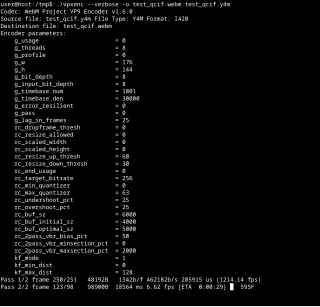
Ogg is a free, open container format maintained by the Xiph.Org Foundation. The authors of the Ogg format state that it is unrestricted by software patents and is designed to provide for efficient streaming and manipulation of high-quality digital multimedia. Its name is derived from "ogging", jargon from the computer game Netrek.
QuickTime is a discontinued extensible multimedia architecture created by Apple, which supports playing, streaming, encoding, and transcoding a variety of digital media formats. The term QuickTime also refers to the QuickTime Player front-end media player application, which is built-into macOS, and was formerly available for Windows.
Windows Media Audio (WMA) is a series of audio codecs and their corresponding audio coding formats developed by Microsoft. It is a proprietary technology that forms part of the Windows Media framework. WMA consists of four distinct codecs. The original WMA codec, known simply as WMA, was conceived as a competitor to the popular MP3 and RealAudio codecs. WMA Pro, a newer and more advanced codec, supports multichannel and high resolution audio. A lossless codec, WMA Lossless, compresses audio data without loss of audio fidelity. WMA Voice, targeted at voice content, applies compression using a range of low bit rates. Microsoft has also developed a digital container format called Advanced Systems Format to store audio encoded by WMA.
Windows Media Video (WMV) is a series of video codecs and their corresponding video coding formats developed by Microsoft. It is part of the Windows Media framework. WMV consists of three distinct codecs: The original video compression technology known as WMV, was originally designed for Internet streaming applications, as a competitor to RealVideo. The other compression technologies, WMV Screen and WMV Image, cater for specialized content. After standardization by the Society of Motion Picture and Television Engineers (SMPTE), WMV version 9 was adapted for physical-delivery formats such as HD DVD and Blu-ray Disc and became known as VC-1. Microsoft also developed a digital container format called Advanced Systems Format to store video encoded by Windows Media Video.
Nero Digital is a brand name applied to a suite of MPEG-4-compatible video and audio compression codecs developed by Nero AG of Germany and Ateme of France. The audio codecs are integrated into the Nero Digital Audio+ audio encoding tool for Microsoft Windows, and the audio & video codecs are integrated into Nero's Recode DVD ripping software.

On2 Technologies, formerly known as The Duck Corporation, was a small publicly traded company, founded in New York City in 1992 and headquartered in Clifton Park, New York, that designed video codec technology. It created a series of video codecs called TrueMotion.

High-Efficiency Advanced Audio Coding (HE-AAC) is an audio coding format for lossy data compression of digital audio defined as an MPEG-4 Audio profile in ISO/IEC 14496–3. It is an extension of Low Complexity AAC (AAC-LC) optimized for low-bitrate applications such as streaming audio. The usage profile HE-AAC v1 uses spectral band replication (SBR) to enhance the modified discrete cosine transform (MDCT) compression efficiency in the frequency domain. The usage profile HE-AAC v2 couples SBR with Parametric Stereo (PS) to further enhance the compression efficiency of stereo signals.
Flash Video is a container file format used to deliver digital video content over the Internet using Adobe Flash Player version 6 and newer. Flash Video content may also be embedded within SWF files. There are two different Flash Video file formats: FLV and F4V. The audio and video data within FLV files are encoded in the same way as SWF files. The F4V file format is based on the ISO base media file format, starting with Flash Player 9 update 3. Both formats are supported in Adobe Flash Player and developed by Adobe Systems. FLV was originally developed by Macromedia. In the early 2000s, Flash Video was the de facto standard for web-based streaming video. Users include Hulu, VEVO, Yahoo! Video, metacafe, Reuters.com, and many other news providers.
Α video codec is software or a device that provides encoding and decoding for digital video, and which may or may not include the use of video compression and/or decompression. Most codecs are typically implementations of video coding formats.
Asao is a proprietary single-channel (mono) codec and compression format optimized for low-bitrate transmission of audio, developed by Nellymoser Inc.
AVC-Intra is a type of video coding developed by Panasonic, and then supported in products made by other companies. AVC-Intra is available in Panasonic's high definition broadcast products, such as, for example, their P2 card equipped broadcast cameras.

VP8 is an open and royalty-free video compression format released by On2 Technologies in 2008.

libvpx is a free software video codec library from Google and the Alliance for Open Media (AOMedia). It serves as the reference software implementation for the VP8 and VP9 video coding formats, and for AV1 a special fork named libaom that was stripped of backwards compatibility.
Adaptive bitrate streaming is a technique used in streaming multimedia over computer networks. While in the past most video or audio streaming technologies utilized streaming protocols such as RTP with RTSP, today's adaptive streaming technologies are based almost exclusively on HTTP, and are designed to work efficiently over large distributed HTTP networks. Adaptive bitrate streaming works by detecting a user's bandwidth and CPU capacity in real time, adjusting the quality of the media stream accordingly. It requires the use of an encoder which encodes a single source media at multiple bit rates. The player client switches between streaming the different encodings depending on available resources. "The result: very little buffering, fast start time and a good experience for both high-end and low-end connections."

x265 is an encoder for creating digital video streams in the High Efficiency Video Coding (HEVC/H.265) video compression format developed by the Joint Collaborative Team on Video Coding (JCT-VC). It is available as a command-line app or a software library, under the terms of GNU General Public License (GPL) version 2 or later; however, customers may request a commercial license.

Opus is a lossy audio coding format developed by the Xiph.Org Foundation and standardized by the Internet Engineering Task Force, designed to efficiently code speech and general audio in a single format, while remaining low-latency enough for real-time interactive communication and low-complexity enough for low-end embedded processors. Opus replaces both Vorbis and Speex for new applications, and several blind listening tests have ranked it higher-quality than any other standard audio format at any given bitrate until transparency is reached, including MP3, AAC, and HE-AAC.
Sorenson Media was an American software company specializing in video encoding technology. Established in December 1995 as Sorenson Vision, the company developed technology which was licensed and ultimately acquired from Utah State University. The company first announced its codec at a developer’s preview at MacWorld Expo in January 1997.
Codec 2 is a low-bitrate speech audio codec that is patent free and open source. Codec 2 compresses speech using sinusoidal coding, a method specialized for human speech. Bit rates of 3200 to 450 bit/s have been successfully created. Codec 2 was designed to be used for amateur radio and other high compression voice applications.

VP9 is an open and royalty-free video coding format developed by Google.
Apple ProRes is a high quality, "visually lossless" lossy video compression format developed by Apple Inc. for use in post-production that supports video resolution up to 8K. It is the successor of the Apple Intermediate Codec and was introduced in 2007 with Final Cut Studio 2. Much like the H.26x and MPEG standards, the ProRes family of codecs use compression algorithms based on the discrete cosine transform (DCT). ProRes is widely used as a final format delivery method for HD broadcast files in commercials, features, Blu-ray and streaming.








